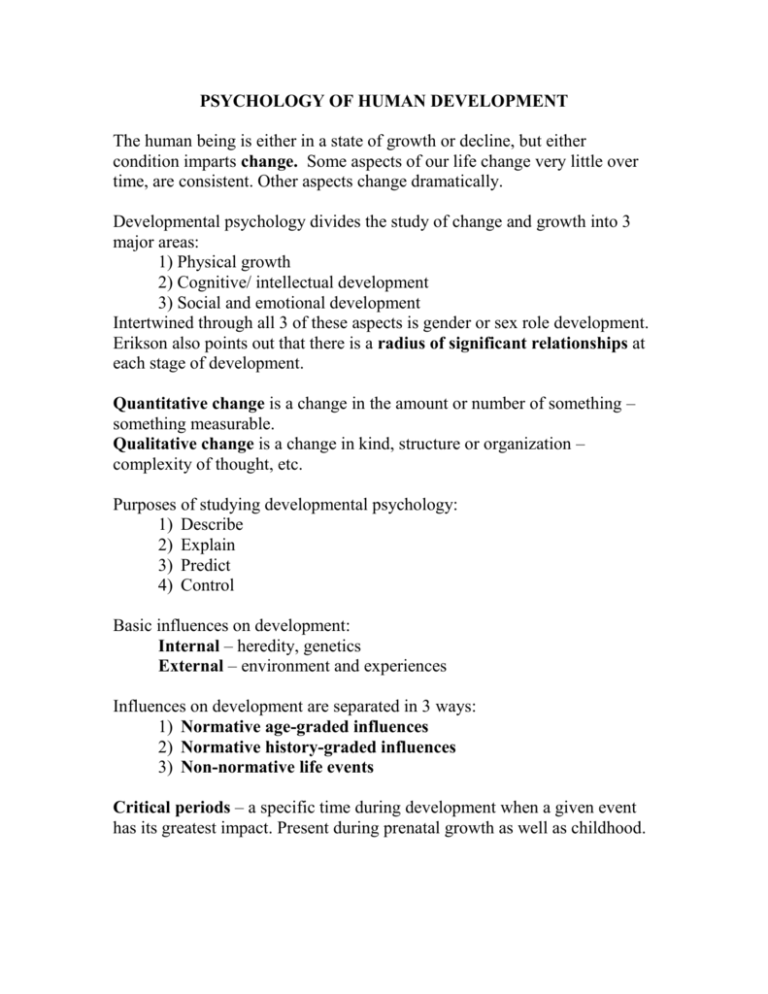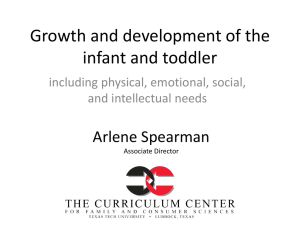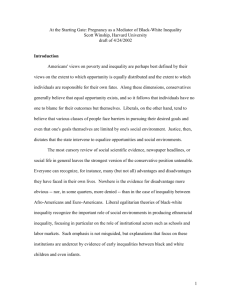Theories of Development
advertisement

PSYCHOLOGY OF HUMAN DEVELOPMENT The human being is either in a state of growth or decline, but either condition imparts change. Some aspects of our life change very little over time, are consistent. Other aspects change dramatically. Developmental psychology divides the study of change and growth into 3 major areas: 1) Physical growth 2) Cognitive/ intellectual development 3) Social and emotional development Intertwined through all 3 of these aspects is gender or sex role development. Erikson also points out that there is a radius of significant relationships at each stage of development. Quantitative change is a change in the amount or number of something – something measurable. Qualitative change is a change in kind, structure or organization – complexity of thought, etc. Purposes of studying developmental psychology: 1) Describe 2) Explain 3) Predict 4) Control Basic influences on development: Internal – heredity, genetics External – environment and experiences Influences on development are separated in 3 ways: 1) Normative age-graded influences 2) Normative history-graded influences 3) Non-normative life events Critical periods – a specific time during development when a given event has its greatest impact. Present during prenatal growth as well as childhood. Human development is studied using the scientific method of observation, testing of hypothesis, analysis of data, public dissemination of finding, and repeatable studies. Methods of study: 1) Non-experimental techniques: a) Case studies b) Observation- naturalistic, laboratory, field c) Interviews d) Surveys e) Correlational studies – show relationship between possibly related variables, does not establish causation. Measured with a correlational coefficient. 2) Experimental Methods – rigorously controlled procedures wherein the investigator manipulates variables to learn how on affects the other. It is replicable so others can test results themselves. a) Independent variable-something the researcher controls (suggested cause) b) Dependent variable – the result which is measured and affected (or not) by IV (effect) Generally you need more than one group to test against – Control group – same as experimental group but is not exposed to treatment. Samples must be randomly selected and assigned. Randomness controls for other variables affecting outcome. Only experimental methods can define cause and effect clearly. Development may be studied: 1) Cross-sectionally 2) Longitudinally 3) Cross-sequentially Ethics of Research 1) Informed Consent 2) Deception 3) Self-esteem 4) Privacy 5) Risk vs. Benefit assessment Theories of Development 1) Psychoanalytic (and Psychosocial) – concerned with unconscious forces motivating human behavior. Began with Freud at the turn of the 20 th Century. First stage theory Stages: a) Oral b) Anal c) Phallic d) Latency e) Genital Structure: a) Id b) Ego c) Superego Psychosocial – Erikson’s theory carried Freud’s concepts all through life span. Raised society as a force in developing the personality. He contributed the idea of 8 stages of development, each with its own crisis or task to resolve in order to move on in maturation. 2) Behavioral and Social Cognitive – mechanistic perspective which views human development as a response to events. Sees development as change coming through adapting to the environment. a) Classical Conditioning- Pavlovian theory of internal responses being conditioned to environmental triggers, stimuli (John Watson) b) Operant Conditioning – Skinner studied voluntary responses learned in response to environmental stimuli and reinforcers. c) Social Learning – Bandura studied learning through observing and imitating modeling. 3) Cognitive theories- organismic perspective that sees people as active agents in their development, and development progressing qualitatively. Piaget’s Cognitive Developmental theory said that people change through principles of adaptation: This is a theory of intellectual development. Principles: a) Organization b) Adaptation 1) assimilation 2) accommodation c) Equilibration Stages: a) Sensorimotor- Birth to 2 years old b) Preoperational – 2 - 7 years c) Concrete operational – 7 – 11 years d) Formal operational – 11 years through adulthood Vygotsky’s Sociocultural Cognitive theory- emphasizes that children construct knowledge which studies the role of language and social relationships in learning and development. The Information Processing Approach –describes how people manipulate information, monitor it and strategize about it. Uses computer models to describe the human memory and retrieval system. 4) Ecological Theory- Bronfenbrenner expanded the idea of children being affected by their environment to include 4 levels of social systems: a) Microsystem b) Mesosystem c) Exosystem d) Macrosystem The environment changes as the child grows, so the influence changes. 5) Ethological Theory – stresses that development is influenced by biology, evolutionary demands, with critical and sensitive periods that must be satisfied to see optimal development. Darwinian theory affected Lorenz and later Bowlby in his attachment theory. 6) Eclectic Theory – an approach which does not follow any one theoretical approach, but instead selects and uses whatever is considered in many theories. Many theories made a significant contribution to understanding human growth and development. Many models guide research. CONCEPTION THROUGH BIRTH Fertilization happens about 14 days after the beginning of a woman’s menstrual period, when the _______________fuse to form a single cell. Two gametes form a zygote which begins to reproduce. ________ are produced at a rate of several 100 million per day. For fertilization to occur, it requires as many as 20 million sperm attacking the ovum with amino acids to break down the tough outer coating of the ovum so one sperm can enter. Sperm are only able to fertilize an egg for 48 hours, ova can be fertilized up to ___________ after release. Multiple births occur in two ways: 1) Ovulation releases 2 ova and both are fertilized – ________ twins. 2) Division of a fertilized ovum into two identical zygotes which begin multiplying and becoming ___________ twins. Father determines the sex of the child because he offers ____________ chromosomes. Mom only has XX. More males are conceived, but more males die at every age in gestation and even after birth. Basic unit of heredity is the ______ which is made up of strands of DNA. Genes carry the program for every inherited characteristic. ______________ define dominance and recessiveness of various characteristics. It requires a pair of alleles from each parent to match and determine which characteristic is expressed. Expressed characteristics: Phenotype The underlying genetic pattern is the genotype. Expressed traits may pass through many generations without showing up to affect child: hemophilia, color blindness – ________________________. Other chromosomal abnormalities happen due to a missing chromosome or an extra chromosome (Down’s syndrome – an extra 21st chromosome) ___________________takes tissues of both parents and analyzes genetic makeup to see what the risk is for certain diseases. Heredity vs. Environment – how do these influences affect the growing baby? Genes cap the potential, ____________allows one to reach as close to that potential as possible. Maturation – much development is just programmed into genes, the pattern and timing of developing skills and abilities is predetermined. Heredity draws the __________for development. Environment affects the_______ of construction. Intelligence is one of the easiest traits to determine influencegenes establish a range of possible reactions to experience, and experience enhances that to maximum potential or restricts it. Disorders influenced by heredity and environment: 1) Alcoholism – genetic connection, also affected by family systems. 2) Schizophrenia- genetic predisposition toward it but stress can trigger onset. 3) Infantile autism- seems to have a genetic component, boys afflicted 3X more than girls. 4) Depression- women 3X more incidence than in men, 2-3X more common in close relatives of depressed people. 70% concordance in identical twins. Prenatal Development in 3 stages: 1) Germinal – conception to 2 weeks. Blastocyst develops into placenta, amniotic sac and umbilical cord. 2) Embryonic- 2 to 8/12 weeks as major organ systems are developing. Critical period for baby if exposed to environmental toxins, disease. 3) Fetal stage- 8/12 weeks to Birth. Prenatal environment: 1) Good nutrition 2) Careful about drug intake: Fetal Alcohol Syndrome and FAE, Marijuana, Nicotine, Opiates, Cocaine 3) Maternal illness – rubella, AIDs, Rh incompatibility, toxoplasmosis, toxemia 4) Xrays, lead exposure, chemical exposure Forms of birth 1) Medicated delivery – may use oxytocin to induce labor 2) Natural, prepared childbirth – Lamaze 3) Leboyer method 4) Caesarian delivery – more risky to mother and baby – baby has better prognosis if it has to go through the struggle through birth canal – releases stress hormones (catecholamines) that clear the lungs and enhance chances of survival Problems during birth 1) Breech position 2) Anoxia 3) Placenta previa 4) Birth trauma or injury – 2nd most common cause of neonatal death. Neonatal period – 1st 4 weeks of life- average size is 20” long, 7.5 lbs. Skull may be misshapen due to time in birth canal – fontanels allow for baby’s head to pass through birth canal.. May be fuzzy – lanugo. Skin may be so transparent capillaries show. If liver is not functioning well, skin may be yellow with jaundice. Usually lose 10% of birth weight, lack of fat contributes to problems with temperature control. Brain is plastic, but can be permanently affected by malnutrition. Primitive reflexes contribute to survival. Medical assessments of newborns: 1) APGAR 2) PKU test 3) Brazelton Neonatal Behavioral Assessment Problems after birth: 1) Low birthweight – 5.5 lbs or less – often related to hyaline membrane disease- infant massage can help baby thrive. 2) SIDS – most often occurs between 2 – 4 months Principles of development: 1) Cephalocaudal 2) Proximodistal 3) Simple to complex Growth patterns: At 5 months, birthweight doubles. At one year – weigh 3X birthweight At two years – weigh 4X birthweight Nutrition: Breastfeeding has come back in favor – considered the ultimate health food, aids bonding, contributes to heightened immunity, more digestible. Marasmus- wasting disease caused by inadequate protein supply. Senses: Touch is first to develop – rooting reflex. They can feel pain. Taste – prefer sweet things Smell- prefer mother’s smell immediately after birth Hearing- show a preference for stories read to them before birth and for mother’s voice. Sight- at birth they can follow a moving target, by age 3 have adult acuity. Prefer faces to objects. Depth perception – visual cliff. Motor abilities: the most human behaviors are the pincer grip and walking on two legs. Denver Developmental Screening Test gives norms for physical abilities. A major turning point is self-produced locomotion. There is a major reorganization of brain function when baby begins to crawl. It also develops a sense of mastery and confidence. Bayley Scales of Motor Skills measure how babies interact with their environment- has a mental scale, a motor scale, and infant behavior profile. Exercise classes for babies seem to have beneficial effects on children’s development (must be careful with baby swim classes that babies don’t swallow too much water). In general, stimulation of every type enhances brain development. The more stimulation, the more interactive connections between neurons which ultimately can protect from degenerative diseases such as Alzheimer’s. Intelligence Testing of Infants: Developmental Quotient (DQ): developed by Gesell to sort normal functioning babies from abnormal ones. Particularly useful for adoption agencies and potential parents. DQ combines motor, language, adaptive and personal-social measures to give an overall score. Fagan Test of Infant Intelligence focuses on infant’s ability to process information, recognize attributes of objects, finding similarities and differences between objects, forming mental representations. They use habituation measures to distinguish objects they are familiar with from new objects. All these tests are useful for measuring the effects of malnutrition, drugs, maternal deprivation and stimulation on infants. In general, infant intelligence measures do not predict childhood intelligence.











